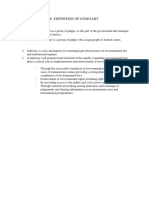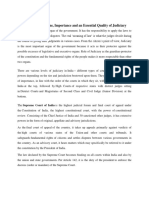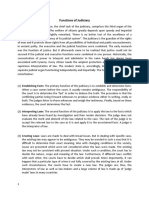0 ratings0% found this document useful (0 votes)
88 viewsJUDICIARY
JUDICIARY
Uploaded by
EvaThe document discusses the importance of an independent judiciary in India. It argues that an independent judiciary is necessary to protect citizens' fundamental rights, ensure no misuse of power by other branches of government, and uphold the rule of law. It describes some ways the independence of the judiciary is protected, such as through difficult procedures for judges' removal and financial independence. The judiciary's role in interpreting the constitution through judicial review and protecting fundamental rights is also summarized.
Copyright:
© All Rights Reserved
Available Formats
Download as DOCX, PDF, TXT or read online from Scribd
JUDICIARY
JUDICIARY
Uploaded by
Eva0 ratings0% found this document useful (0 votes)
88 views2 pagesThe document discusses the importance of an independent judiciary in India. It argues that an independent judiciary is necessary to protect citizens' fundamental rights, ensure no misuse of power by other branches of government, and uphold the rule of law. It describes some ways the independence of the judiciary is protected, such as through difficult procedures for judges' removal and financial independence. The judiciary's role in interpreting the constitution through judicial review and protecting fundamental rights is also summarized.
Copyright
© © All Rights Reserved
Available Formats
DOCX, PDF, TXT or read online from Scribd
Share this document
Did you find this document useful?
Is this content inappropriate?
The document discusses the importance of an independent judiciary in India. It argues that an independent judiciary is necessary to protect citizens' fundamental rights, ensure no misuse of power by other branches of government, and uphold the rule of law. It describes some ways the independence of the judiciary is protected, such as through difficult procedures for judges' removal and financial independence. The judiciary's role in interpreting the constitution through judicial review and protecting fundamental rights is also summarized.
Copyright:
© All Rights Reserved
Available Formats
Download as DOCX, PDF, TXT or read online from Scribd
Download as docx, pdf, or txt
0 ratings0% found this document useful (0 votes)
88 views2 pagesJUDICIARY
JUDICIARY
Uploaded by
EvaThe document discusses the importance of an independent judiciary in India. It argues that an independent judiciary is necessary to protect citizens' fundamental rights, ensure no misuse of power by other branches of government, and uphold the rule of law. It describes some ways the independence of the judiciary is protected, such as through difficult procedures for judges' removal and financial independence. The judiciary's role in interpreting the constitution through judicial review and protecting fundamental rights is also summarized.
Copyright:
© All Rights Reserved
Available Formats
Download as DOCX, PDF, TXT or read online from Scribd
Download as docx, pdf, or txt
You are on page 1of 2
JUDICIARY
WHY DO WE NEED AN INDEPENDENT JUDICIARY?
The independent Judiciary allows the court to play a central role in securing that there is no misuse of powers of the
Legislature and executive.
It also protects the fundamental rights of the citizens because anyone can approach the court if they believe that their rights
have been violated.
The principal role of the judiciary is to protect rule of law and ensure supremacy of law. It safeguards rights of the individual,
settles disputes in accordance with the law and ensures that democracy does not give way to individual or group dictatorship.
Independence Of Judiciary?
The other organs of the government like the executive and legislature must not restrain the functioning of the judiciary in
such a way that it is unable to do justice.
The other organs of the government should not interfere with the decision of the judiciary.
Judges must be able to perform their functions without fear or favour.
#Independence of the judiciary does not imply arbitrariness or absence of accountability. Judiciary is a part of the democratic
political structure of the country. It is therefore accountable to the Constitution, to the democratic traditions and to the people of
the country.
How Can The Independence Of Judiciary Be Provided & Protected?
1. The legislature is not involved in the process of appointment of judges.
2. The judges have a fixed tenure. They hold office till reaching the age of retirement. Only in exceptional cases, judges may be
removed.
3. The Constitution prescribes a very difficult procedure for removal of judges.
4. The judiciary is not financially dependent on either the executive or legislature. The Constitution provides that the salaries
and allowances of the judges are not subjected to the approval of the legislature.
5. The judiciary has the power to penalize those who are found guilty of contempt of court.
6. Parliament cannot discuss the conduct of the judges except when the proceeding to remove a judge is being carried out.
Appointment Of Judges
#The appointment of judges has never been free from political controversy. Council of Ministers, Governors and Chief Ministers
and Chief Justice of India — all influence the process of judicial appointment.
Chief Justice of India (CJI) – Senior most judge of the Supreme Court.
Broken twice – 1973 & 1975.
The other Judges of the Supreme Court and the High Court are appointed by the President after ‘consulting’ the CJI.
The Chief Justice should recommend names of persons to be appointed in consultation with four senior-most judges of the
Court. Thus, the Supreme Court has established the principle of collegiality in making recommendations for appointments.
Removal Of Judges
The removal of judges of the Supreme Court and the High Courts is also extremely difficult.
A judge of the Supreme Court or High Court can be removed only on the ground of misbehaviour or incapacity.
A motion containing the charges against the judge must be approved by special majority in both Houses of the Parliament.
Special majority requires a majority of 2/3rd members present and voting supported by more than 50% of the total
strength of the house.
# It should also be noted that while in making appointments, the executive plays a crucial role; the legislature has the
powers of removal. This has ensured both balance of power and independence of the judiciary.
STRUCTURE OF THE JUDICIARY
The Constitution of India provides for a single integrated judicial system.
The structure of the judiciary in India is pyramidal with the Supreme Court at the top, High Courts below them and district
and subordinate courts at the lowest level.
The lower courts function under the direct superintendence of the higher courts.
Jurisdiction Of Supreme Court
1. Original Jurisdiction :-
o Original jurisdiction means cases that can be directly considered by the Supreme Court without going to the lower courts
before that.
o It is called original jurisdiction because the Supreme Court alone has the power to deal with such cases.
o In this capacity, the Supreme Court not just settles disputes but also interprets the powers of Union and State government
as laid down in the Constitution.
o Here Supreme Court Settles disputes between Union and States and amongst States.
2. Writ Jurisdiction :-
o Any individual, whose fundamental right has been violated, can directly move the Supreme Court for remedy. The
Supreme Court can give special orders in the form of writs.
3. Appellate Jurisdiction :-
o A person can appeal to the Supreme Court against the decisions of the High Court. Means that the Supreme Court will
reconsider the case and the legal issues involved in it.
o The Supreme Court holds the powers to decide whether to admit appeals even when the High Court do not allow appeal.
o The High Courts too, have appellate jurisdiction over the decisions given by courts below them.
4. Advisory Jurisdiction :-
o This means that the President of India can refer any matter that is of public importance or that which involves
interpretation of Constitution to Supreme Court for advice. However, the Supreme Court is not bound to give advice on
such matters and the President is not bound to accept such an advice. Benefits of Advisory Jurisdiction are :-
Ϙ It allows the government to seek legal opinion on a matter of importance before taking action on it.
Ϙ In the light of the advice of the Supreme Court, the government can make suitable changes in its action or
legislations.
JUDICIAL ACTIVISM
The chief instrument through which judicial activism has flourished in India is Public Interest Litigation (PIL) or Social
Action Litigation (SAL).
What is PIL?
In normal course of law, an individual can approach the courts only if he/she has been personally aggrieved.
Here PIL means that a litigation has been filed in a court of law, for the protection of “Public Interest”, such as Pollution,
Terrorism, Road safety, Constructional hazards etc. Any matter where the interest of public at large is affected can be
redressed by filing a Public Interest Litigation in a court of law.
Impact Of Judicial Activism
Positive Impact :-
It has democratized the judicial system by giving not just to individuals but also groups access to the courts.
It has forced executive accountability.
It has also made an attempt to make the electoral system much more free and fair.
Negative Impact :-
In the first place it has overburdened the courts.
judicial activism has blurred the line of distinction between the executive and legislature on the one hand and the judiciary on
the other. The court has been involved in resolving questions which belong to the executive.
JUDICIARY & RIGHTS
The Constitution provides two ways in which the Supreme Court can remedy the violation of rights.
First it can restore fundamental rights by issuing writs of Habeas Corpus; mandamus etc. (article 32). The High Courts
also have the power to issue such writs (article 226).
Secondly, the Supreme Court can declare the concerned law as unconstitutional and therefore non-operational (article
13).
Constitution establish the Supreme Court as the protector of fundamental rights of the citizen on the one hand and interpreter
of Constitution on the other.
Judicial Review
Judicial Review means the power of the Supreme Court (or High Courts) to examine the constitutionality of any law if the
Court arrives at the conclusion that the law is inconsistent with the provisions of the Constitution, such a law is declared as
unconstitutional and inapplicable.
in the case of federal relations too, the Supreme Court can use the review powers if a law is inconsistent with the distribution
of powers laid down by the Constitution.
In particular, the review power means that the judiciary can interpret the Constitution and the laws passed by the legislature.
JUDICIARY & PARLIAMENT
The Indian Constitution is based on a delicate principle of limited separation of powers and checks and balances. This means
that each organ of the government has a clear area of functioning.
Thus, the Parliament is supreme in making laws and amending the Constitution, the executive is supreme in implementing
them while the judiciary is supreme in settling disputes and deciding whether the laws that have been made are in accordance
with the provisions of the Constitution.
Despite such clear-cut division of power, the conflict between the Parliament and judiciary remained. E.g., Right to Property
& Keshavananda Bharati case.
You might also like
- Unarmed Security Guard ApplicationDocument1 pageUnarmed Security Guard ApplicationPedro Cadena0% (1)
- NPPE NotesDocument31 pagesNPPE NotesAdam ZafarNo ratings yet
- Case Study:: ReflectionDocument2 pagesCase Study:: ReflectionRhia shin PasuquinNo ratings yet
- Product Supply Agreement B2BDocument5 pagesProduct Supply Agreement B2BArjun ZmNo ratings yet
- Judicial System in IndiaDocument14 pagesJudicial System in IndiacharlieNo ratings yet
- NotesDocument17 pagesNotesloxigamer7No ratings yet
- Class 11 Political Science - JudiciaryDocument14 pagesClass 11 Political Science - JudiciaryRamita Udayashankar40% (5)
- Judiciary 17Document7 pagesJudiciary 17Jatin SoniNo ratings yet
- Judiciary 1Document5 pagesJudiciary 1KriegerNo ratings yet
- Hierarchy of Courts in IndiaDocument27 pagesHierarchy of Courts in IndiaAashka JaniNo ratings yet
- JUDICIARYDocument3 pagesJUDICIARYeternalnoireNo ratings yet
- JudiciaryDocument4 pagesJudiciaryharsiratk123No ratings yet
- Pol JudiciaryDocument9 pagesPol JudiciaryAlok RaghuvanshiNo ratings yet
- Judicisl Process 1Document9 pagesJudicisl Process 1zoma itrat khanNo ratings yet
- Legislation Notes: Judiciary:: 1. To Give Justice To The PeopleDocument8 pagesLegislation Notes: Judiciary:: 1. To Give Justice To The Peoplesimran yadavNo ratings yet
- The Union JudiciaryDocument7 pagesThe Union Judiciarylmg.ashmitadasNo ratings yet
- Judiciary PDFDocument16 pagesJudiciary PDFPaarth VijaraniaNo ratings yet
- Wa0067.Document14 pagesWa0067.PurshotamNo ratings yet
- Legal Studies Ch-1 Judiciary XIIDocument25 pagesLegal Studies Ch-1 Judiciary XIIsarthak49620No ratings yet
- Supreme Court PDFDocument9 pagesSupreme Court PDFNaveen ReddyNo ratings yet
- Unit 3 The Legal SystemDocument10 pagesUnit 3 The Legal SystemIIHT VARANASINo ratings yet
- Constitution ProjectDocument11 pagesConstitution ProjectAkshat BoseNo ratings yet
- The Roleof Judiciaryin IndiaDocument6 pagesThe Roleof Judiciaryin IndiaSheela AravindNo ratings yet
- CHAPTER 5 Political ScienceDocument3 pagesCHAPTER 5 Political Scienceanshika1792010No ratings yet
- Independence of JudiciaryDocument6 pagesIndependence of JudiciaryChetan SharmaNo ratings yet
- Chap - 6Document5 pagesChap - 6meettuabraham172002No ratings yet
- Definition of JudiciaryDocument8 pagesDefinition of JudiciaryshraddhaNo ratings yet
- Independence of Supreme CourtDocument21 pagesIndependence of Supreme Courtshivangi paliwalNo ratings yet
- (EAI) ADRNJudicialIndependence IndiaDocument11 pages(EAI) ADRNJudicialIndependence IndiaSwapardeshiNo ratings yet
- The JudiciaryDocument5 pagesThe JudiciarykanhaiyagiwardiaNo ratings yet
- Judiciary Lec 8Document6 pagesJudiciary Lec 8Hafiz Omer Abdullah Omer AbdullahNo ratings yet
- Political ScienceDocument30 pagesPolitical Sciencesampurnarastogi06No ratings yet
- JUDICIARYDocument30 pagesJUDICIARYYASHVI PHOGAT 9439No ratings yet
- Chapter 06: Judiciary Any 1 Question Out of 4 Likely To Come in ExamDocument4 pagesChapter 06: Judiciary Any 1 Question Out of 4 Likely To Come in ExamAqib ShaikhNo ratings yet
- The Judiciary of Pakistan Is A Hierarchical System With Two Classes of CourtsDocument3 pagesThe Judiciary of Pakistan Is A Hierarchical System With Two Classes of CourtsMueed AbidNo ratings yet
- JudiciaryDocument16 pagesJudiciarysd2261377No ratings yet
- Judiciary Moot CourtDocument13 pagesJudiciary Moot CourtManju UppalNo ratings yet
- Unit 4Document3 pagesUnit 4xifoh46742No ratings yet
- Judiciary 1Document18 pagesJudiciary 1PallaviNo ratings yet
- Constitution 1st UnitDocument19 pagesConstitution 1st Unitgoodsservice467No ratings yet
- Independence of JudiciaryDocument11 pagesIndependence of JudiciaryBhanuNo ratings yet
- Austin Has Defined Administrative Law. As The Law, Which Determines The Ends and Modes ToDocument8 pagesAustin Has Defined Administrative Law. As The Law, Which Determines The Ends and Modes ToBernie BenastoNo ratings yet
- Supreme Court PoliticsDocument28 pagesSupreme Court Politicsandreafrancis704No ratings yet
- JudiciaryDocument10 pagesJudiciaryAnantha KrishnaNo ratings yet
- 33 50afcatDocument6 pages33 50afcataradhya.shinde8cNo ratings yet
- CIVICS Ls 5 Judiciary NotesDocument17 pagesCIVICS Ls 5 Judiciary NotesKrithikStudyDa DaNo ratings yet
- Judicial ActivismDocument9 pagesJudicial Activismkhushi guptaNo ratings yet
- JudiciaryDocument4 pagesJudiciaryShazedul Haque 1931727630No ratings yet
- JudiciaryDocument4 pagesJudiciarywwwguddisingh260No ratings yet
- L14 - Indian - JudiciaryDocument13 pagesL14 - Indian - Judiciaryshafinsq15No ratings yet
- The Judiciary-Notes CBSE Class 11 Political SDocument1 pageThe Judiciary-Notes CBSE Class 11 Political Schauhanvinee4141No ratings yet
- JudiciaryDocument12 pagesJudiciaryafralamisa2020No ratings yet
- NotesDocument2 pagesNotesmr.hike.09No ratings yet
- Lesson 10 Functions of The Judicial BranchDocument4 pagesLesson 10 Functions of The Judicial BranchJeff LacasandileNo ratings yet
- 3 Organs of Government Legislature Executive and JudiciaryDocument22 pages3 Organs of Government Legislature Executive and JudiciaryRitesh50% (2)
- Judiciary HandoutDocument3 pagesJudiciary Handoutsweetyappu88No ratings yet
- JudiciaryDocument15 pagesJudiciaryteamumatteraismvNo ratings yet
- Judicial Process - Independence of JudiciaryDocument28 pagesJudicial Process - Independence of JudiciarykalaivaniNo ratings yet
- Chapter 6Document4 pagesChapter 6vivekhiremath58No ratings yet
- Union Judiciary Part IIDocument23 pagesUnion Judiciary Part IIDevendraNo ratings yet
- Constitution LawDocument25 pagesConstitution Lawn9821531759No ratings yet
- Enc Encoded 4 M Wes 8 P4 A 8 RVL VZHYz NY4 Uu 2 ZD KM 7 X QBT4 Aqlol EYGsj KTNRDNG WJADocument5 pagesEnc Encoded 4 M Wes 8 P4 A 8 RVL VZHYz NY4 Uu 2 ZD KM 7 X QBT4 Aqlol EYGsj KTNRDNG WJASaketh JainNo ratings yet
- What Are The Powers of Supreme Court of India? - Political Science - Knowledge HubDocument5 pagesWhat Are The Powers of Supreme Court of India? - Political Science - Knowledge HubAnshul YadavNo ratings yet
- Climate Class XIDocument15 pagesClimate Class XIEvaNo ratings yet
- LEGISLATUREDocument4 pagesLEGISLATUREEvaNo ratings yet
- Ch. 1 Political Theory Introduction - Political Science Theory Class 11Document4 pagesCh. 1 Political Theory Introduction - Political Science Theory Class 11EvaNo ratings yet
- Geomorphic Processes On Earth SurfaceDocument20 pagesGeomorphic Processes On Earth SurfaceEvaNo ratings yet
- Contributions of Roman CivilizationDocument14 pagesContributions of Roman CivilizationEvaNo ratings yet
- Anglo-Saxons 2.1 (Grade 5 History)Document18 pagesAnglo-Saxons 2.1 (Grade 5 History)JoannaNo ratings yet
- PDF FilesDocument70 pagesPDF Fileszarbaz khan Afridi khanNo ratings yet
- Memorandum: Philippine National Police, Police Regional Office 2 Cagayan Police Provincial OfficeDocument8 pagesMemorandum: Philippine National Police, Police Regional Office 2 Cagayan Police Provincial OfficejmarNo ratings yet
- Advertisment Regulation in IndiaDocument9 pagesAdvertisment Regulation in IndiapinkeshparvaniNo ratings yet
- Bài tập Phrasal Verb 1.7Document3 pagesBài tập Phrasal Verb 1.7Nguyễn Tuấn ĐạtNo ratings yet
- 19th and 20th Amendments of Constitution of PakistanDocument7 pages19th and 20th Amendments of Constitution of PakistanJahangir Ali KandhirNo ratings yet
- CIR Vs PNBDocument9 pagesCIR Vs PNBDenise Michaela YapNo ratings yet
- Sexuality and Sex TherapyDocument19 pagesSexuality and Sex TherapyPetar DimkovNo ratings yet
- Troop Meeting Plan FormDocument1 pageTroop Meeting Plan FormSTARTTOLOOKNo ratings yet
- Concept Paper Corruption and Human RightsDocument4 pagesConcept Paper Corruption and Human Rightsapple renz alayNo ratings yet
- Lumauig vs. PeopleDocument2 pagesLumauig vs. PeopleAnne Kerstine BastinenNo ratings yet
- Alfred McCoyDocument21 pagesAlfred McCoyAngel IquinNo ratings yet
- Macbeth AnalysisDocument14 pagesMacbeth Analysissisinityw100% (6)
- Securities and Exchange Commission LawDocument25 pagesSecurities and Exchange Commission LawDyrene Rosario Ungsod75% (4)
- Orion HistoryDocument181 pagesOrion HistoryRichard Alboro100% (1)
- Plaintiff-Appellee Vs Vs Defendant-Appellant Camilo Formoso Solicitor General Ambrosio Padilla Assistant Solicitor General Esmeraldo UmaliDocument5 pagesPlaintiff-Appellee Vs Vs Defendant-Appellant Camilo Formoso Solicitor General Ambrosio Padilla Assistant Solicitor General Esmeraldo UmaliMeg ReyesNo ratings yet
- Two One Act PlaysDocument3 pagesTwo One Act PlaysMohammad UmairNo ratings yet
- Renewal Form For RSA Security TokenDocument2 pagesRenewal Form For RSA Security TokenSpcmb DocketNo ratings yet
- Newobwdeadheadstest PDFDocument3 pagesNewobwdeadheadstest PDFCristian Mauricio Salas Adriázola0% (1)
- Burgos vs. Chief of Staff G.R. No. L-64261 December 26, 1984 FactsDocument4 pagesBurgos vs. Chief of Staff G.R. No. L-64261 December 26, 1984 FactsFrancis MoraledaNo ratings yet
- Far-Right Activists Rally in Austria Calling For End To The Great Replacement' - EuronewsDocument11 pagesFar-Right Activists Rally in Austria Calling For End To The Great Replacement' - EuronewsMarouane El BahraouiNo ratings yet
- Feraren vs. CADocument7 pagesFeraren vs. CAMitch Gaviola BasasNo ratings yet
- In Re The Delhi Laws Act 1912 23051951 SCs510010 11303Document203 pagesIn Re The Delhi Laws Act 1912 23051951 SCs510010 11303IshikaNo ratings yet
- Israel Shahak Holocaust InformationDocument2 pagesIsrael Shahak Holocaust Informationkravic14No ratings yet
- Self-Emancipation and 4B MovementDocument2 pagesSelf-Emancipation and 4B MovementAnjehyn ElleNo ratings yet
- Citizenship Act 1955Document10 pagesCitizenship Act 1955anusid45No ratings yet






























































































